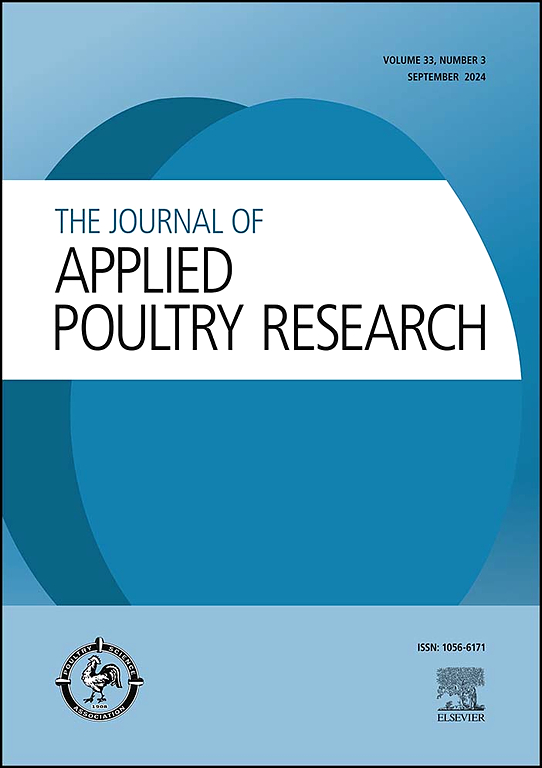应用研究说明:黑兵蝇幼虫碎屑是肉鸡日粮的有效饲料成分
IF 1.6
3区 农林科学
Q2 AGRICULTURE, DAIRY & ANIMAL SCIENCE
引用次数: 0
摘要
多年来,非商业禽群的日粮中一直在成功使用黑兵蝇幼虫(BSFL)。但其可用性和成本阻碍了商业家禽生产商对其的采用。由外骨骼、小幼虫、消化饲料和剩余饲料组成的生产副产品碎屑主要被用作肥料。鸡粪的营养成分使其适合用于动物饲料,而 BSFL 鸡粪的产量和成本对于商业家禽生产商来说都是可行的。该产品含有月桂酸、甲壳素和抗菌肽,可改善动物的整体健康。在本研究中,我们进行了两项实验,以检验与对照日粮相比,在肉鸡日粮中添加 BSFL 糠对生长性能的影响。BSFL 糠在开食期的添加量为 2.5%,在生长期为 5.0%,在育成期为 10%。两项实验的每个处理均采用 10 次重复。总体而言,两个实验(分别为实验 1 和实验 2)的采食量(P=0.091,P=0.845)、体重增加(P=0.433,P=0.619)或饲料转化率(FCR)(P=0.060,P=0.727)均无差异。这些结果表明,BSFL 糠可以作为一种有效、安全的饲料原料用于商业肉鸡生产。本文章由计算机程序翻译,如有差异,请以英文原文为准。
Applied research note: Black Soldier Fly Larvae Frass is an effective feed ingredient for broiler diets
Black Soldier Fly Larvae (BSFL) have been successfully utilized in the diets of noncommercial poultry flocks for many years. Availability and cost have hindered its adoption by commercial poultry producers. Frass, a production byproduct, comprising exoskeletons, small larvae, digested feed, and leftover feedstock has predominately been used as fertilizer. The nutrient content of frass makes it appropriate for use in animal feed, and BSFL frass is produced at a volume and cost that is viable for commercial poultry producers. This product contains lauric acid, chitin, and antimicrobial peptides, which may improve overall animal health. In this study, two experiments were conducted to examine the impact of BSFL Frass inclusion in broiler diets on growth performance compared to a control diet.
Diets in this study were formulated to be isonitrogenous and isocaloric. Frass from BSFL was included at 2.5 % in the starter phase, 5.0 % in the grower phase, and 10 % in the finisher phase. Both experiments utilized 10 replicates per treatment. Overall, no differences were noted in feed intake (P=0.091, P=0.845), bodyweight gain (P=0.433, P=0.619), or feed conversion ratio (FCR) (P=0.060, P=0.727) in either Experiment (Experiment 1 and Experiment 2, respectively). These results indicate that BSFL frass can be an effective and safe feed ingredient option for commercial broiler production.
求助全文
通过发布文献求助,成功后即可免费获取论文全文。
去求助
来源期刊

Journal of Applied Poultry Research
农林科学-奶制品与动物科学
CiteScore
4.10
自引率
10.50%
发文量
80
审稿时长
104 days
期刊介绍:
The Journal of Applied Poultry Research (JAPR) publishes original research reports, field reports, and reviews on breeding, hatching, health and disease, layer management, meat bird processing and products, meat bird management, microbiology, food safety, nutrition, environment, sanitation, welfare, and economics. As of January 2020, JAPR will become an Open Access journal with no subscription charges, meaning authors who publish here can make their research immediately, permanently, and freely accessible worldwide while retaining copyright to their work. Papers submitted for publication after October 1, 2019 will be published as Open Access papers.
The readers of JAPR are in education, extension, industry, and government, including research, teaching, administration, veterinary medicine, management, production, quality assurance, product development, and technical services. Nutritionists, breeder flock supervisors, production managers, microbiologists, laboratory personnel, food safety and sanitation managers, poultry processing managers, feed manufacturers, and egg producers use JAPR to keep up with current applied poultry research.
 求助内容:
求助内容: 应助结果提醒方式:
应助结果提醒方式:


